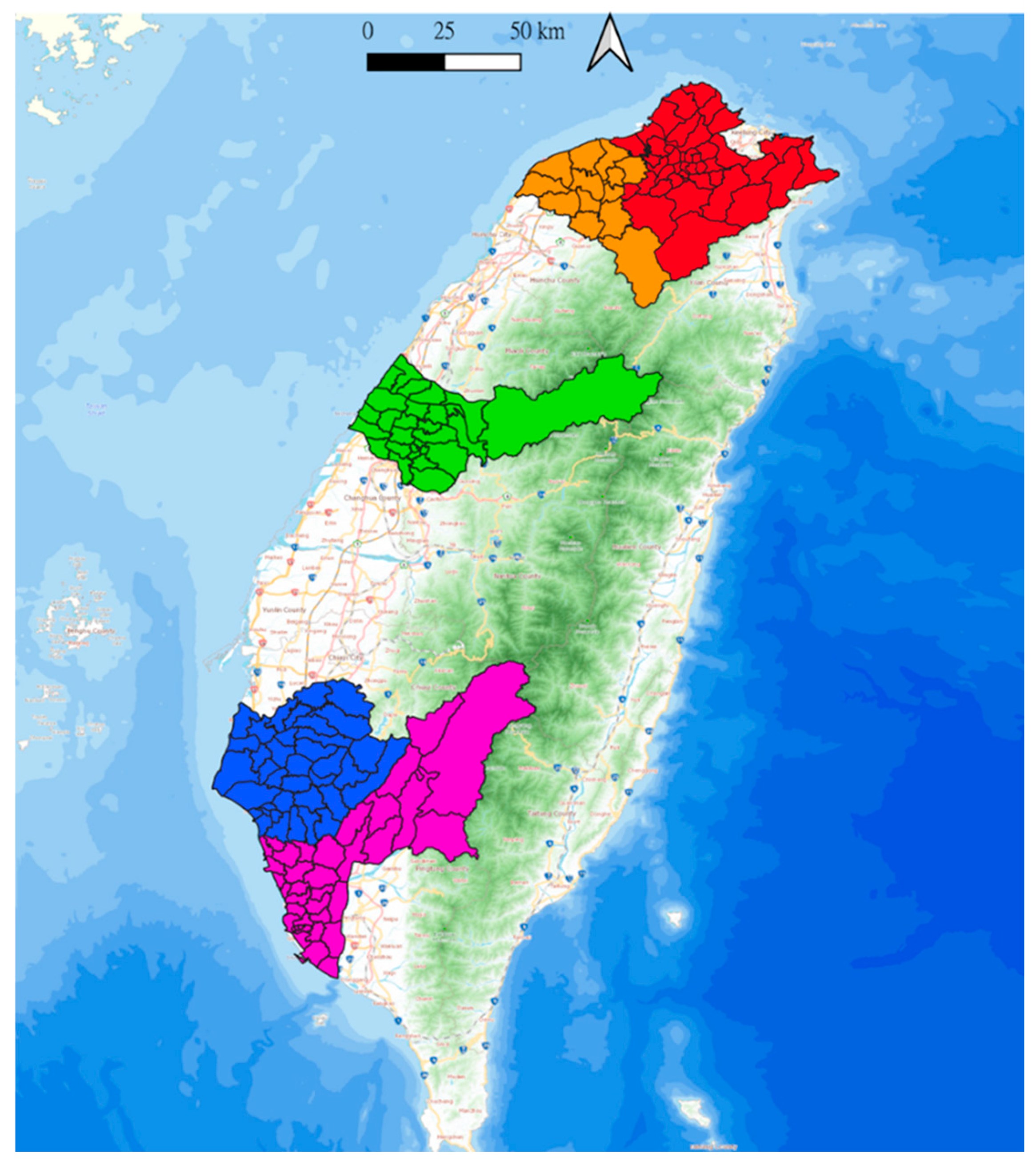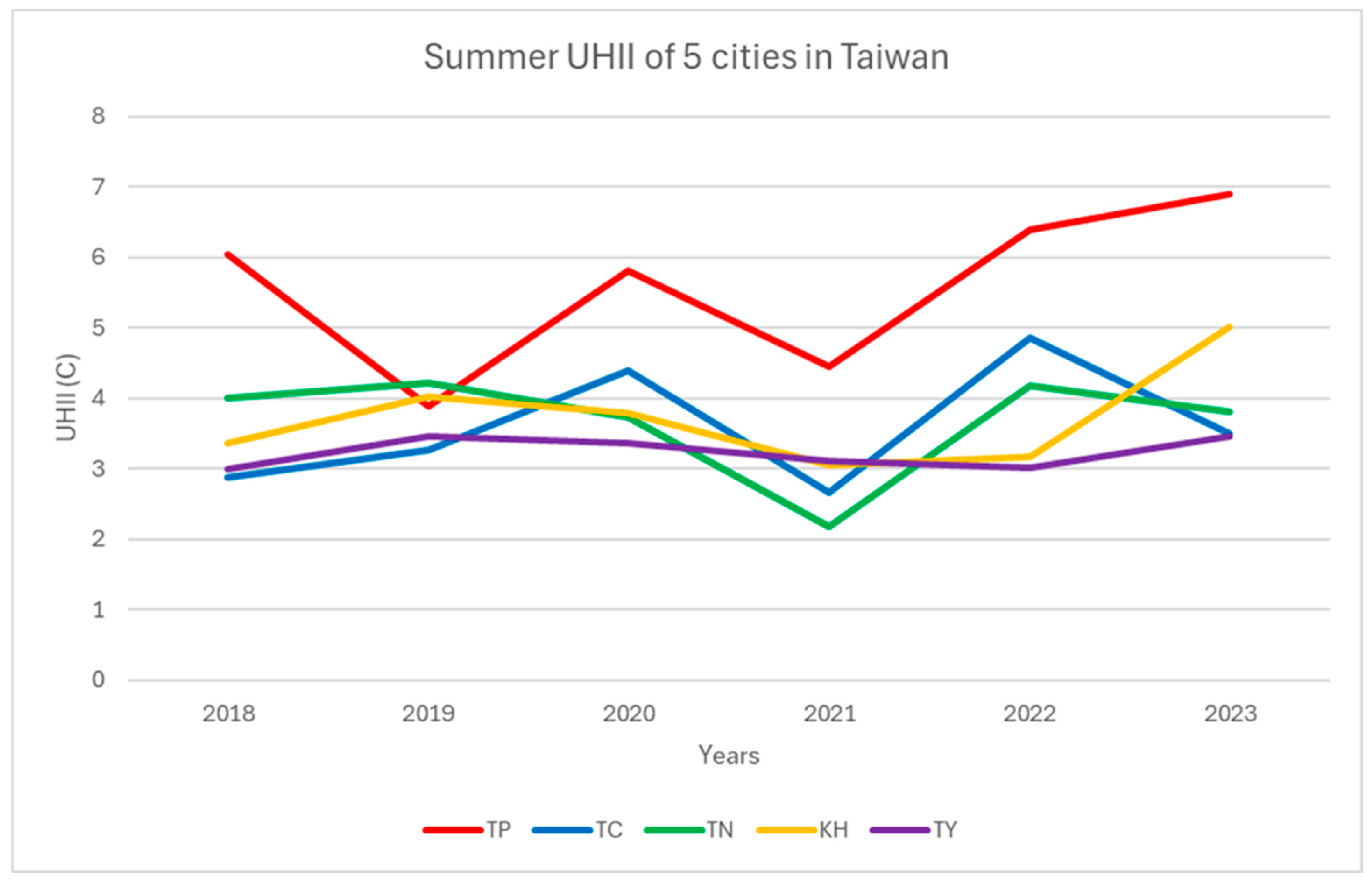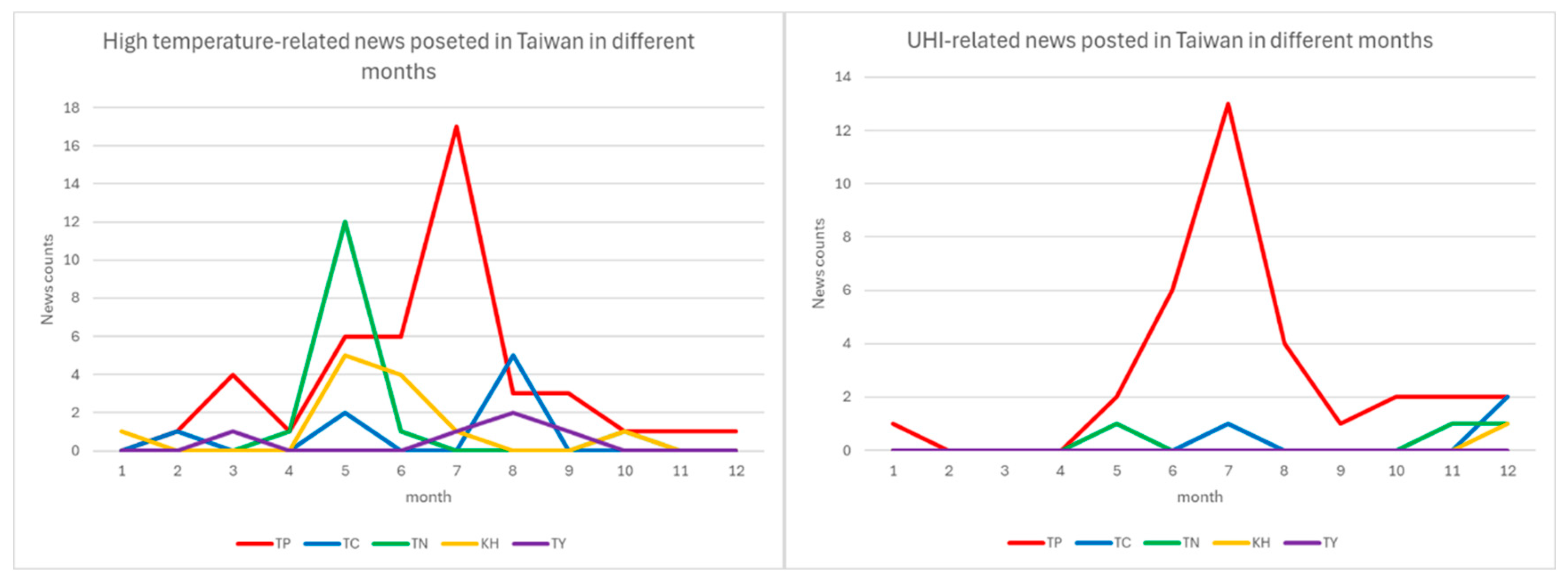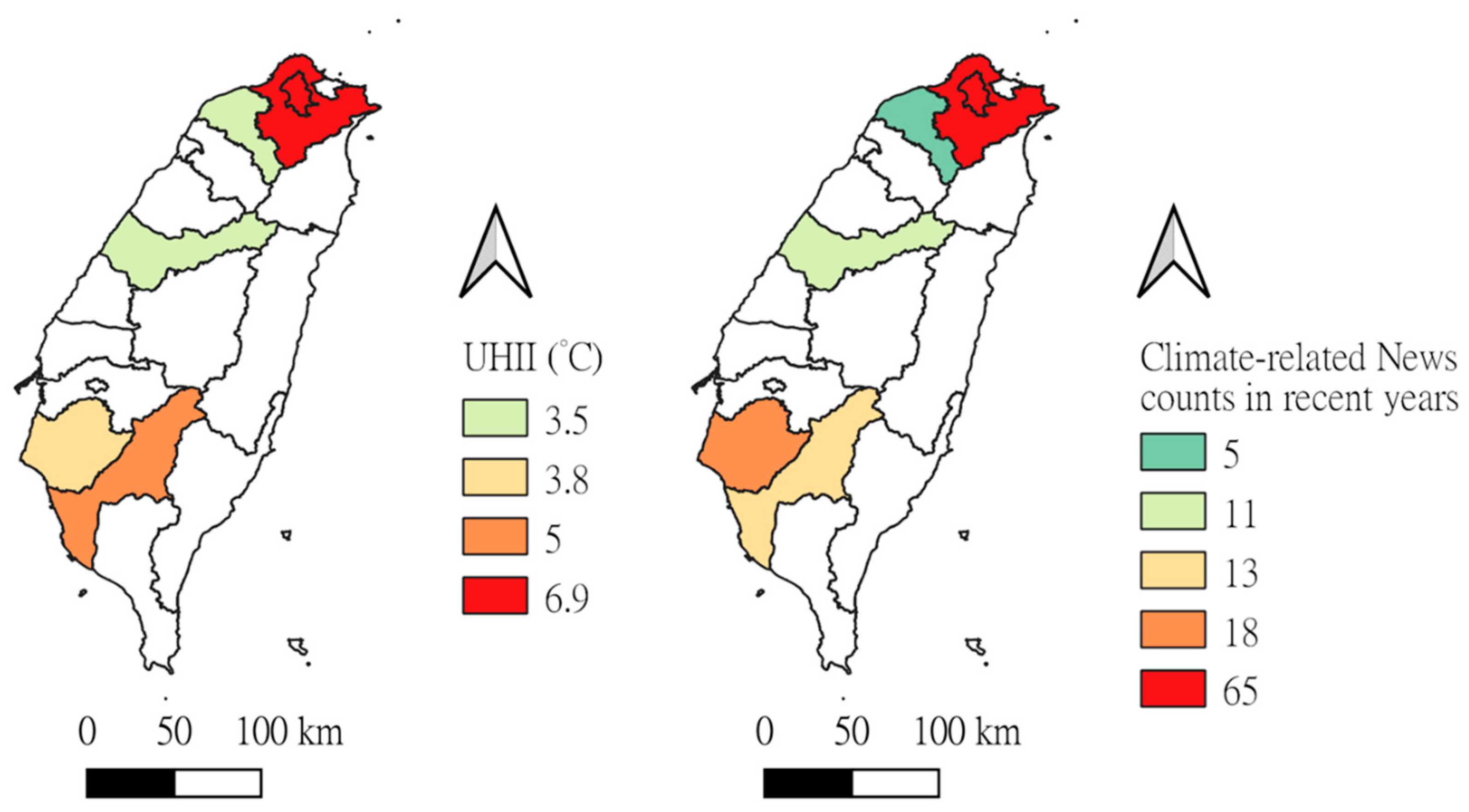Urban Heat Island Effect and Unequal Temperature-Related News Attention in Taiwan’s Major Cities
Abstract
1. Introduction
2. Materials and Methods
2.1. Research Areas
2.2. Meteorological Data
2.3. Urban Heat Island Intensity
2.4. Data Mining: Web Crawler
- (1)
- Two keywords (in traditional Chinese) were selected and applied to search the related news from Google News using a web crawler: “UHI” and “high temperature”.
- (2)
- Because of the large number of news items that were searched and collected, further filtering is required. Therefore, regional criteria were applied, such as “Taiwan”, “our country”, the name of Taiwan’s cities, “air temperature”, “hot”, and “climate”. A total of 35 sub-keywords were further applied to filter the related news.
- (3)
- Finally, the UHI- and high temperature-related news were identified and sorted based on their regions, published years, and published months.
3. Results
3.1. UHI Distribution in Five Cities in Taiwan
3.2. UHII in Five Cities in Taiwan
3.3. High Temperature and UHI Related News Counts in Taiwan
4. Discussions
4.1. UHI Effect Is Not Only in Taipei
4.2. Why Are All Media Focused on Taiwan but Not on Other Cities?
4.3. Limitations and Suggestions
5. Conclusions
Author Contributions
Funding
Data Availability Statement
Acknowledgments
Conflicts of Interest
References
- Lin, P.; Lau, S.S.Y.; Qin, H.; Gou, Z. Effects of urban planning indicators on urban heat island: A case study of pocket parks in high-rise high-density environment. Landsc. Urban Plan. 2017, 168, 48–60. [Google Scholar] [CrossRef]
- Lau, T.K.; Lin, T.P. Investigating the relationship between air temperature and the intensity of urban development using on-site measurement, satellite imagery and machine learning. Sustain. Cities Soc. 2024, 100, 104982. [Google Scholar] [CrossRef]
- Lin, F.Y.; Huang, K.T.; Lin, T.P.; Hwang, R.L. Generating hourly local weather data with high spatially resolution and the applications in bioclimatic performance. Sci. Total Environ. 2019, 653, 1262–1271. [Google Scholar] [CrossRef]
- Singh, N.; Singh, S.; Mall, R.K. Urban ecology and human health: Implications of urban heat island, air pollution and climate change nexus. In Urban Ecology; Elsevier: Amsterdam, The Netherlands, 2020; pp. 317–334. [Google Scholar]
- Zhao, J.; Hu, C.; Li, Z.; Zhang, M.; Fan, H.; Li, K.; Yuan, R. Investigating the quantitative impact of the vegetation indices on the urban thermal comfort based on machine learning: A case study of the Qinhuai River Basin, China. Sustain. Cities Soc. 2025, 125, 106357. [Google Scholar] [CrossRef]
- Zhang, M.; Tan, S.; Zhang, C.; Chen, E. Machine learning in modelling the urban thermal field variance index and assessing the impacts of urban land expansion on seasonal thermal environment. Sustain. Cities Soc. 2024, 106, 105345. [Google Scholar] [CrossRef]
- Lin, C.Y.; Chen, F.; Huang, J.C.; Chen, W.C.; Liou, Y.A.; Chen, W.N.; Liu, S.C. Urban heat island effect and its impact on boundary layer development and land–sea circulation over northern Taiwan. Atmos. Environ. 2008, 42, 5635–5649. [Google Scholar] [CrossRef]
- Liu, B.; Guo, X.; Jiang, J. How urban morphology relates to the urban heat island effect: A multi-indicator study. Sustainability 2023, 15, 10787. [Google Scholar] [CrossRef]
- Lai, L.W.; Cheng, W.L. Air temperature change due to human activities in Taiwan for the past century. Int. J. Climatol. 2010, 30, 432–444. [Google Scholar] [CrossRef]
- Wong, N.H.; Tan, C.L.; Kolokotsa, D.D.; Takebayashi, H. Greenery as a mitigation and adaptation strategy to urban heat. Nat. Rev. Earth Environ. 2021, 2, 166–181. [Google Scholar] [CrossRef]
- Lau, T.K.; Tsai, P.C.; Ou, H.Y.; Lin, T.P. Efficient and cost-effective method for identifying urban ventilation corridors using a heuristic search algorithm. Sustain. Cities Soc. 2024, 101, 105144. [Google Scholar] [CrossRef]
- Tan, J.K.; Belcher, R.N.; Tan, H.T.; Menz, S.; Schroepfer, T. The urban heat island mitigation potential of vegetation depends on local surface type and shade. Urban For. Urban Green. 2021, 62, 127128. [Google Scholar] [CrossRef]
- Wang, C.H.; Lin, W.Z.; Peng, T.R.; Tsai, H.C. Temperature and hydrological variations of the urban environment in the Taipei metropolitan area, Taiwan. Sci. Total Environ. 2008, 404, 393–400. [Google Scholar] [CrossRef] [PubMed]
- Chen, Y.C.; Lo, T.W.; Shih, W.Y.; Lin, T.P. Interpreting air temperature generated from urban climatic map by urban morphology in Taipei. Theor. Appl. Climatol. 2019, 137, 2657–2662. [Google Scholar] [CrossRef]
- Mabon, L.; Shih, W.Y. Mapping the socio-political landscape of heat mitigation through urban greenspaces: The case of Taipei Metropolis. Environ. Urban. 2019, 31, 552–574. [Google Scholar] [CrossRef]
- Wu, C.D.; Lung, S.C.C.; Jan, J.F. Development of a 3-D urbanization index using digital terrain models for surface urban heat island effects. ISPRS J. Photogramm. 2013, 81, 1–11. [Google Scholar] [CrossRef]
- Chang, H.T. A temporal and spatial analysis of urban heat island in basin city utilizing remote sensing techniques. Int. Arch. Photogramm. Remote Sens. Spat. Inf. Sci. 2016, 41, 165–170. [Google Scholar] [CrossRef]
- Hwang, R.L.; Lin, C.Y.; Huang, K.T. Spatial and temporal analysis of urban heat island and climate change on residential thermal comfort and cooling energy in Taiwan. Energy Build. 2017, 152, 804–812. [Google Scholar] [CrossRef]
- Shih, W. Greenspace patterns and the mitigation of land surface temperature in Taipei metropolis. Habitat Int. 2017, 60, 69–80. [Google Scholar] [CrossRef]
- Hsieh, C.M.; Huang, H.C. Mitigating urban heat islands: A method to identify potential wind corridor for cooling and ventilation. Comput. Environ. Urban Syst. 2016, 57, 130–143. [Google Scholar] [CrossRef]
- Lin, Z.A.; Chang, C.; Lin, T.P. Designers’ Guided Site Shading Strategies: A Simplified Model for Radiative Cooling. Build. Environ. 2024, 259, 111824. [Google Scholar] [CrossRef]
- Lin, W.Z.; Tsai, H.C.; Wang, C.H.; Wu, K.Y. The subtropical urban heat island effect revealed in eight major cities of Taiwan. In Proceedings of the WSEAS International Conference on Environment, Ecosystems and Development, Venice, Italy, 2–4 November 2005; pp. 14–20. [Google Scholar]
- Chen, Y.C.; Yao, C.K.; Honjo, T.; Lin, T.P. The application of a high-density street-level air temperature observation network (HiSAN): Dynamic variation characteristics of urban heat island in Tainan, Taiwan. Sci. Total Environ. 2018, 626, 555–566. [Google Scholar] [CrossRef]
- Huang, J.M.; Chen, L.C. A numerical study on mitigation strategies of urban heat islands in a tropical megacity: A case study in Kaohsiung City, Taiwan. Sustainability 2020, 12, 3952. [Google Scholar] [CrossRef]
- Wijsman, K.; Berbés-Blázquez, M. What do we mean by justice in sustainability pathways? Commitments, dilemmas, and translations from theory to practice in nature-based solutions. Environ. Sci. Policy 2022, 136, 377–386. [Google Scholar] [CrossRef]
- Walker, G. Beyond distribution and proximity: Exploring the multiple spatialities of environmental justice. Antipode 2009, 41, 614–636. [Google Scholar] [CrossRef]
- Sultana, F. Critical climate justice. Geogr. J. 2022, 188, 118–124. [Google Scholar] [CrossRef]
- Dolšak, N.; Prakash, A. Three faces of climate justice. Annu. Rev. Political Sci. 2022, 25, 283–301. [Google Scholar] [CrossRef]
- Chen, C.C.; Wang, Y.R.; Wang, Y.C.; Lin, S.L.; Chen, C.T.; Lu, M.M.; Guo, Y.L.L. Projection of future temperature extremes, related mortality, and adaptation due to climate and population changes in Taiwan. Sci. Total Environ. 2021, 760, 143373. [Google Scholar] [CrossRef]
- Liou, C.S.; Chen, J.H.; Terng, C.T.; Wang, F.J.; Fong, C.T.; Rosmond, T.E.; Kuo, H.-C.; Shiao, C.-H.; Cheng, M.-D. The second–generation global forecast system at the central weather bureau in Taiwan. Weather Forecast. 1997, 12, 653–663. [Google Scholar] [CrossRef]
- Taheri-Shahraiyni, H.; Sodoudi, S. High-resolution air temperature mapping in urban areas: A review on different modelling techniques. Therm. Sci. 2017, 21 Pt A, 2267–2286. [Google Scholar] [CrossRef]
- Hsu, S.; Mavrogianni, A.; Hamilton, I. Comparing spatial interpolation techniques of local urban temperature for heat-related health risk estimation in a subtropical city. Procedia Eng. 2017, 198, 354–365. [Google Scholar] [CrossRef]
- Lau, T.K.; Chen, Y.C.; Lin, T.P. Application of local climate zones combined with machine learning to predict the impact of urban structure patterns on thermal environment. Urban Clim. 2023, 52, 101731. [Google Scholar] [CrossRef]
- Szymanowski, M.; Kryza, M. Local regression models for spatial interpolation of urban heat island—An example from Wrocław, SW Poland. Theor. Appl. Climatol. 2012, 108, 53–71. [Google Scholar] [CrossRef]
- Nistor, M.M.; Rahardjo, H.; Satyanaga, A.; Hao, K.Z.; Xiaosheng, Q.; Sham, A.W.L. Investigation of groundwater table distribution using borehole piezometer data interpolation: Case study of Singapore. Eng. Geol. 2020, 271, 105590. [Google Scholar] [CrossRef]
- Memon, R.A.; Leung, D.Y.; Liu, C.H. An investigation of urban heat island intensity (UHII) as an indicator of urban heating. Atmos. Res. 2009, 94, 491–500. [Google Scholar] [CrossRef]
- Lin, T.P.; Yang, S.R.; Chen, Y.C.; Matzarakis, A. The potential of a modified physiologically equivalent temperature (mPET) based on local thermal comfort perception in hot and humid regions. Theor. Appl. Climatol. 2019, 135, 873–876. [Google Scholar] [CrossRef]
- Cui, Y.; Yan, D.; Hong, T.; Ma, J. Temporal and spatial characteristics of the urban heat island in Beijing and the impact on building design and energy performance. Energy 2017, 130, 286–297. [Google Scholar] [CrossRef]
- Asp, K. Fairness, Informativeness and Scrutiny: The Role of News Media in Democracy. Nord. Rev. 2007, 28, 31–49. [Google Scholar]
- Hillebrand, C. The role of news media in intelligence oversight. In Secret Intelligence; Routledge: London, UK, 2019; pp. 396–412. [Google Scholar]
- Wlezien, C. News and public opinion: Which comes first? J. Politics 2024, 86, 1–17. [Google Scholar] [CrossRef]
- Wong, N.H.; Tan, C.L.; Nindyani, A.D.S.; Jusuf, S.K.; Tan, E. Influence of water bodies on outdoor air temperature in hot and humid climate. In Proceedings of the ICSDC 2011: Integrating Sustainability Practices in the Construction Industry, Kansas, MO, USA, 23–25 March 2011; pp. 81–89. [Google Scholar]
- Chen, Y.C.; Lin, T.P.; Lin, C.T. A simple approach for the development of urban climatic maps based on the urban characteristics in Tainan, Taiwan. Int. J. Biometeorol. 2017, 61, 1029–1041. [Google Scholar] [CrossRef]
- Doan, V.Q.; Kusaka, H.; Nguyen, T.M. Roles of past, present, and future land use and anthropogenic heat release changes on urban heat island effects in Hanoi, Vietnam: Numerical experiments with a regional climate model. Sustain. Cities Soc. 2019, 47, 101479. [Google Scholar] [CrossRef]
- Wang, W.; He, B.J. Co-occurrence of urban heat and the COVID-19: Impacts, drivers, methods, and implications for the post-pandemic era. Sustain. Cities Soc. 2023, 90, 104387. [Google Scholar] [CrossRef] [PubMed]
- Rahman, M.N.; Rony, M.R.H.; Jannat, F.A.; Chandra Pal, S.; Islam, M.S.; Alam, E.; Islam, A.R.M.T. Impact of urbanization on urban heat island intensity in major districts of Bangladesh using remote sensing and geo-spatial tools. Climate 2022, 10, 3. [Google Scholar] [CrossRef]
- Shih, W.Y.; Ahmad, S.; Chen, Y.C.; Lin, T.P.; Mabon, L. Spatial relationship between land development pattern and intra-urban thermal variations in Taipei. Sustain. Cities Soc. 2020, 62, 102415. [Google Scholar] [CrossRef] [PubMed]
- Shulman, H.C.; Markowitz, D.M.; Rogers, T. Reading dies in complexity: Online news consumers prefer simple writing. Sci. Adv. 2024, 10, eadn2555. [Google Scholar] [CrossRef]
- Levermore, G.; Parkinson, J.; Lee, K.; Laycock, P.; Lindley, S. The increasing trend of the urban heat island intensity. Urban Clim. 2018, 24, 360–368. [Google Scholar] [CrossRef]
- Yanovitzky, I. Effects of news coverage on policy attention and actions: A closer look into the media-policy connection. Commun. Res. 2002, 29, 422–451. [Google Scholar] [CrossRef]
- Jacobs, S.H.J. Media & Verantwoording over Incidenten: Gevolgen voor Publieke Organisaties. Ph.D. Dissertation, Utrecht University, Utrecht, The Netherlands, 2014. [Google Scholar]
- Figenschou, T.U.; Karlsen, R.; Kolltveit, K.; Schillemans, T. Mounting media pressure: Push and pull forces influencing agendas, resource allocation and decision-making in public bureaucracies. Eur. J. Commun. 2019, 34, 377–394. [Google Scholar] [CrossRef]
- Mavrodieva, A.V.; Rachman, O.K.; Harahap, V.B.; Shaw, R. Role of social media as a soft power tool in raising public awareness and engagement in addressing climate change. Climate 2019, 7, 122. [Google Scholar] [CrossRef]
- Brooker-Gross, S.R. Spatial aspects of newsworthiness. Geogr. Ann. B 1983, 65, 1–9. [Google Scholar] [CrossRef]
- Avraham, E. Cities and their news media images. Cities 2000, 17, 363–370. [Google Scholar] [CrossRef]
- Epstein, E.J. News from Nowhere; Broadview Press: Peterborough, ON, Canada, 1973. [Google Scholar]
- Avraham, E. Media and the Social Construction of Reality: The Coverage of Settlements in Marginal Areas in National Newspapers. Ph.D. Dissertation, Hebrew University of Jerusalem, Jerusalem, Israel, 1998. [Google Scholar]
- Joseph, J.P. Local vs. National: How Twitter Reflects News Coverage of Colin Kaepernick Protests. Master’s Thesis, Louisiana State University and Agricultural and Mechanical College, Baton Rouge, LA, USA, August 2018. [Google Scholar]
- Hoare, A.G. Making the news: Spatial and non-spatial biases in British parliamentary reports of the Rown-tree-Mackintosh takeover. Geogr. Ann. B 1991, 73, 95–109. [Google Scholar] [CrossRef]
- McCann, P. Perceptions of regional inequality and the geography of discontent: Insights from the UK. Reg. Stud. 2020, 54, 256–267. [Google Scholar] [CrossRef]
- Rafsky, S.G. Media mecca or news desert? Covering local news in New York City. Columbia Journalism Review, 7 January 2020. [Google Scholar]
- Kim, E.; Shepherd, M.E.; Clinton, J.D. The effect of big-city news on rural America during the COVID-19 pandemic. Proc. Natl. Acad. Sci. USA 2020, 117, 22009–22014. [Google Scholar] [CrossRef]
- Ohta, R.; Ryu, Y.; Sano, C. Fears related to COVID-19 among rural older people in Japan. Healthcare 2021, 9, 524. [Google Scholar] [CrossRef]
- Chen, Y.C.; Hou, K.S.; Liao, Y.J.; Honjo, T.; Cheng, F.Y.; Lin, T.P. The application of a high-density street-level air temperature observation network (HiSAN): Spatial and temporal variations of thermal and wind condition in different climatic condition types. Sustain. Cities Soc. 2024, 109, 105547. [Google Scholar] [CrossRef]
- Williams, J. Spatial Justice as Analytic Framework. Ph.D. Dissertation, University of Michigan, Ann Arbor, MI, USA, 2018. [Google Scholar]
- Wang, X.; Feng, M.; Qiu, J.; Gu, J.; Zhao, J. From news to forecast: Integrating event analysis in llm-based time series forecasting with reflection. Adv. Neural Inf. Process. Syst. 2024, 37, 58118–58153. [Google Scholar]







| City | Number of Measurement Points | Other Information |
|---|---|---|
| TP | 47 | Air temperature resolution: 0.1 K Update frequency: 1 h |
| TY | 17 | |
| TC | 22 | |
| TN | 39 | |
| KH | 37 |
Disclaimer/Publisher’s Note: The statements, opinions and data contained in all publications are solely those of the individual author(s) and contributor(s) and not of MDPI and/or the editor(s). MDPI and/or the editor(s) disclaim responsibility for any injury to people or property resulting from any ideas, methods, instructions or products referred to in the content. |
© 2025 by the authors. Licensee MDPI, Basel, Switzerland. This article is an open access article distributed under the terms and conditions of the Creative Commons Attribution (CC BY) license (https://creativecommons.org/licenses/by/4.0/).
Share and Cite
Lau, T.-K.; Hsu, H.-C. Urban Heat Island Effect and Unequal Temperature-Related News Attention in Taiwan’s Major Cities. Urban Sci. 2025, 9, 417. https://doi.org/10.3390/urbansci9100417
Lau T-K, Hsu H-C. Urban Heat Island Effect and Unequal Temperature-Related News Attention in Taiwan’s Major Cities. Urban Science. 2025; 9(10):417. https://doi.org/10.3390/urbansci9100417
Chicago/Turabian StyleLau, Tsz-Kin, and Hsieh-Chih Hsu. 2025. "Urban Heat Island Effect and Unequal Temperature-Related News Attention in Taiwan’s Major Cities" Urban Science 9, no. 10: 417. https://doi.org/10.3390/urbansci9100417
APA StyleLau, T.-K., & Hsu, H.-C. (2025). Urban Heat Island Effect and Unequal Temperature-Related News Attention in Taiwan’s Major Cities. Urban Science, 9(10), 417. https://doi.org/10.3390/urbansci9100417





